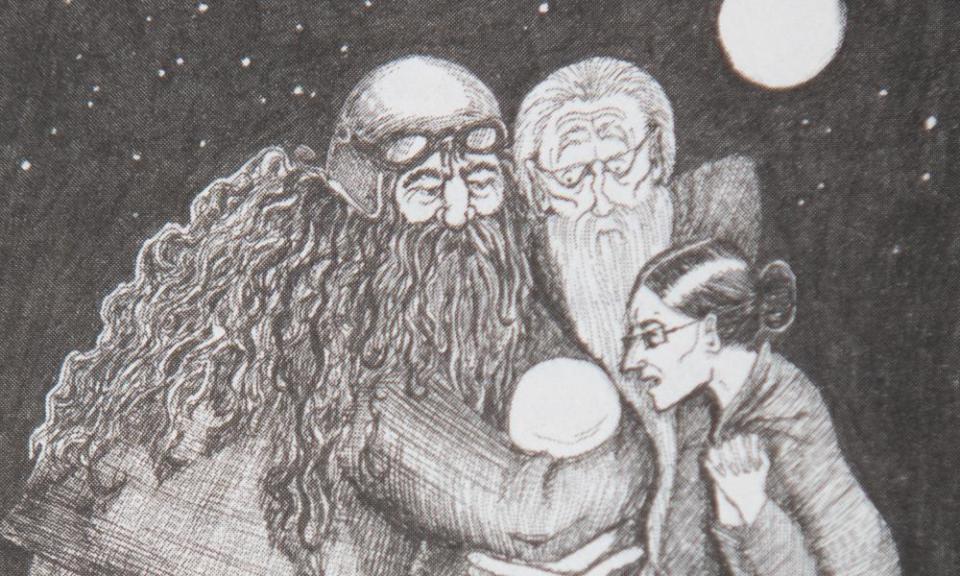Harry Potter and the missing sketches: JK Rowling’s first drawings of boy wizard

Author’s original sketches for her first Hogwarts novel to appear in print – alongside the return of a mysterious wizard
When JK Rowling wrote Harry Potter and the Philosopher’s Stone she didn’t just bring the characters to life with words, she also drew illustrations. They were not included when the book was published, but now the author’s original drawings will appear alongside her story for the first time when the book is reprinted to mark its 25th anniversary.
One sketch shows Rubeus Hagrid, Professor Albus Dumbledore and Professor Minerva McGonagall huddled together in a moonlit Privet Drive, while a small series of five drawings depicts Diagon Alley. All reveal Rowling’s early feeling for characters now familiar to children across the globe as the stars of a series that has sold more than 500m copies and been translated into 80 languages.
The book is reissued next month as part of silver anniversary celebrations, complete this time not only with Rowling’s sketches from the early 1990s, but also with the famous cover drawn in 1996 by a debut designer, Thomas Taylor.
“I’m often asked if I was paralysed by the pressure of producing the cover art for the very first edition,” Taylor, 48, says. “But that is because nowadays it’s hard to imagine a time when no one had heard of Harry Potter at all. I was a newly graduated art student back in 1996, and looking for my first break in illustration.”
It had seemed like a good warm-up job for an aspiring young illustrator: create some artwork for a new children’s book about a schoolboy wizard. Twenty-five years on, and Taylor’s cover has become one of the most recognisable images in world literature.
The new hardback will be on sale for a year, and includes an explanation of a mystery that has long baffled the most devoted readers. When Taylor was commissioned at the age of 23, he was asked to provide an extra image of a wizard for the back cover. Stumped for speedy inspiration, he writes, he drew a study of his own “magical” father, Robert, dressed in a pointy hat and smoking a large pipe. “‘Who is that?,’ readers wanted to know. ‘It’s not Dumbledore, it’s not Quirrell and it’s not Snape’,” he writes.
The pressure to solve the puzzle quickly became intense, with fans suggesting rival interpretations.
“Was there some secret here? Was this a clue to something that would happen in later books? And what was that in the mysterious wizard’s coat pocket?” The questions kept coming, recalls Taylor. “Conspiracy theories began to grow, and the trickle of letters and emails to Bloomsbury became a torrent, until I was eventually asked to replace my father with a painting of Albus Dumbledore.”
Speaking to the Observer, Taylor also resolved another prickly question that has stumped fans – what made the odd shape in the wizard’s deep coat pocket. “I thought it might well be a hedgehog,” he said. “It might be the sort of thing he would need. I wasn’t planning for it to become a huge thing that would follow me through my life, though. You expect your first job to be completely forgotten.”
Taylor’s father died in 2020, and the original sketch was sold at auction after the films came out. “I thought all the old imagery would be replaced for good by film stills,” he said. “I am not sure who has it now.”
This March, a perfectly intact first edition of Harry Potter and the Philosopher’s Stone fetched £69,000 at auction. There were only 500 copies of the first print run in 1997, with about 300 going to libraries and schools and the remainder to bookshops. Crucial typographical errors mark them out, including the double appearance of a wand on the list of items required for pupils at Hogwarts School of Witchcraft and Wizardry, on page 53.
Taylor did not get his own first edition, but when he looks back with pride at the cover illustration, showing “The Boy Who Lived” with his lightning-bolt scar standing next to the Hogwarts Express on Platform Nine and Three-Quarters with his lightning bolt scar, he knows what changes he would make.
“I would do it completely differently now,” he said. “Harry was about to get on the train at King’s Cross, so I felt he should just be in any old clothes. I would put him in something different now. And there may be too much of the station visible.”
Taylor, now an established children’s author with his own series of books, the Eerie-on-Sea Mysteries, optioned for filming, admires Rowling’s images in this edition, which were first seen six years ago on the fan website Pottermore. “I love her drawings,” he said. “I really like it when a writer does their own pictures, and these are really charming. They should be in all the books, really.”
Taylor got his break after he left a portfolio with sample images of wizards and dragons in Bloomsbury’s offices. The publisher phoned him at the children’s bookshop where he worked, and Barry Cunningham – the editor who rescued Rowling’s book from the pile of unsolicited manuscripts from aspiring writers – asked him to paint Harry approaching the Hogwarts Express.
Related: JK Rowling meets Lauren Laverne: ‘Success never feels the way you think it will’
“There was some to-ing and fro-ing about how to draw Harry simultaneously approaching the train from the front, while not presenting the back of his head to the reader, and then I was given a printed manuscript to read on my own train journey home,” he remembers.
As a result, Taylor was one of the first people to read the book.
The anniversary hardback will be published by Bloomsbury Children’s Books on 9 June.

 Yahoo News
Yahoo News 